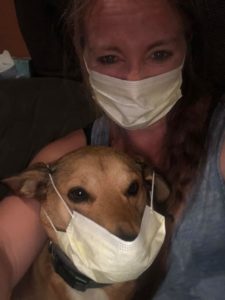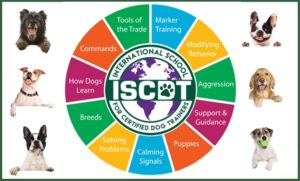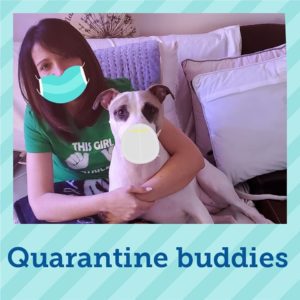 If the summer months don’t provide enough fearful triggers for our dogs– we’re talking fireworks and thunderstorms — this year we can add face masks to the list of possible reactivity issues.
If the summer months don’t provide enough fearful triggers for our dogs– we’re talking fireworks and thunderstorms — this year we can add face masks to the list of possible reactivity issues.
Throughout most of the United States, people are asked (or mandated) to wear facial masks while in public to prevent the spread of Covid 19. This new addition to our daily attire can be disturbing for a dog. Just last week we faced this issue when two client dogs growled during a lesson. The first was fine while we worked together, yet when I sat down to write the family’s homework assignment, the dog growled at me. It wasn’t until he heard my voice that he backed down. That same day, a second canine client ran up to her own family member and growled while this person observed the lesson. In both cases the families were shocked by the dog’s behavior.
Think about it, most of us ditch the mask before we walk into our homes. Until recently, we avoided contact with other people while walking our dogs around the neighborhood. Dogs really haven’t experienced face masks until recently when stay-at-home orders relaxed and service workers and guests stopped by.
ISCDT students learn the importance of observing the whole canine body to determine a dog’s state of mind. This is a skill every dog professional must master. Now, imagine training a dog over the phone or blindfolded. There is no way for you to get cues from a dog you cannot see.
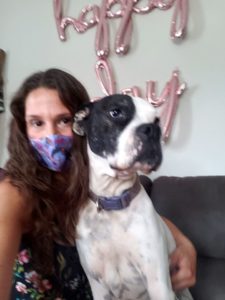 Consider the same scenario from the dog’s point of view. Dogs get their social cues from our facial expressions. They can determine if we are happy (smile) or unhappy (frown) just by observing our features. How does a dog accept social cues from a human face when a mask is blocking the nose and mouth? On top of that, many people wear sunglasses. Now we have unmoving eyes and we lack a nose and mouth. It’s confusing for a dog.
Consider the same scenario from the dog’s point of view. Dogs get their social cues from our facial expressions. They can determine if we are happy (smile) or unhappy (frown) just by observing our features. How does a dog accept social cues from a human face when a mask is blocking the nose and mouth? On top of that, many people wear sunglasses. Now we have unmoving eyes and we lack a nose and mouth. It’s confusing for a dog.
While a dog may be unaffected by one person behind a mask, another could trigger an undesirable response. It is important to desensitize your dog to:
Different people wearing masks (men, women, children of various ages)
Different types of face coverings (bandanna, different color masks, different styles – ie. pointed mask, the respirator masks, flat material mask, paper masks, masks with designs.
Below are steps to help you desensitize dogs to people wearing a mask. Before you start:
- Put the dog on leash
- Keep plenty of high-value treats in your pocket or treat pouch
Steps:
- Hold the mask and invite the dog to smell it (do not shove it in the dog’s face). The dog should willingly smell the mask.
- When he smells the mask, say “yes” and give the dog a treat.
- You may place the mask on the floor, hold it in your hand or hang it off an item like a door handle.
- Repeat the process several times.
Then:
- Have an assistant stand about ten feet away. They should slip the mask on their face. Then can either stand there with the mask or catch the dog’s attention by speaking (example: “Hi.” or make kissing noises). Do not engage in a dialogue with the dog.
- The moment the dog looks at the person wearing the mask, say yes and give the dog a treat. You reward the dog for looking at the person without reacting.
- Repeat this process a few times. Provided the dog looks without reacting, ask the assistant move closer to you (8 feet away)
-
- If at any time, the dog barks, growls or shows discomfort, withhold the treat. Have the person step further back and try again. Practice from a distance in which the dog feels comfortable. We do not want to stress the dog out. When the dog reacts appropriately (no reaction), slowly decrease distance between you and try again.
- Each practice session should last around 5 minutes.
-
- Note: We prefer that the dog look away from the person and turn their attention back to you for the treat. At first, you can lure the dog’s attention back to you with the treat. Eventually, the dog will automatically look in your direction without the lure.
Repeat steps 1 to 3 a few times. Again, the dog responds appropriately, ask the assistant to move up another 2 feet.
- Other exercises to practice with assistants wearing a mask: moving about, sitting, taking the mask on and off and speaking to the dog. As we mentioned above, there should be various people assisting you during this exercise. If you don’t have anyone to help, you can practice this technique while parked in a busy parking lot. Sit in the car with your dog while people in masks walk by. Reward appropriate behavior. Then sit in a park (at a safe distance) and reward your dog for appropriate behavior anytime someone passes wearing a mask.
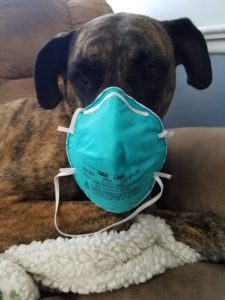 This technique associates the trigger (the mask) to something good (food reward) and in time, should make the dog less reactive toward people wearing masks. Why? Because good things happen when people wear masks.
This technique associates the trigger (the mask) to something good (food reward) and in time, should make the dog less reactive toward people wearing masks. Why? Because good things happen when people wear masks.
This will not happen overnight. You should practice this exercise each day until the dog appears comfortable around people wearing masks.
Always contact a professional dog trainer when dealing with aggressive or troubling behavior.
Written by Katie McKnight
ISCDT’s self-paced, 18-lesson, online course prepares you for a new career as a #dogtrainer. Your personal mentor helps build your skill through written assignments and video submissions of you working with #dogs. This online course is a hands-on program.Visit our website to learn more: https://iscdt.com/product/iscdt-certified-dog-trainer-course/…
Cover Photo by Tobias Rehbein on Unsplash

